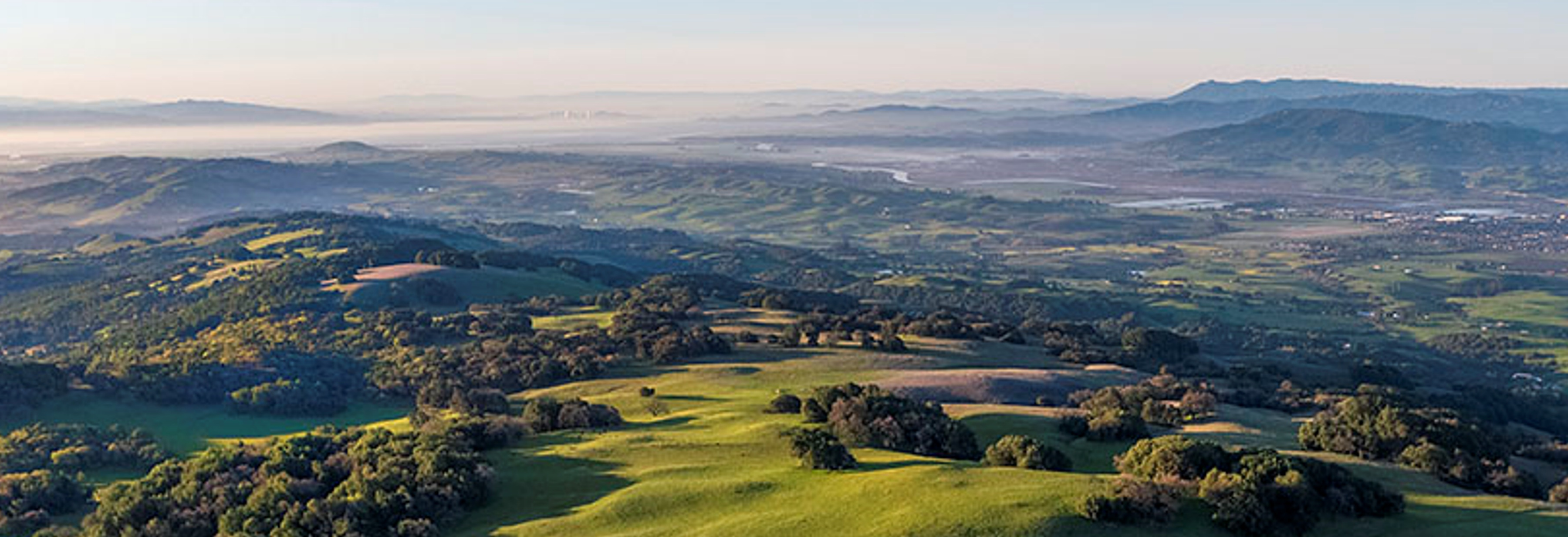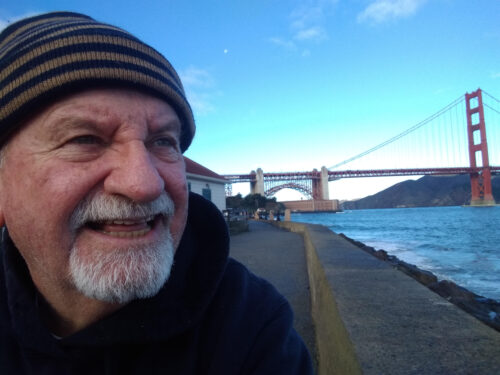SMP Past and Future: A Talk with David Hansen
We recently sat down with David Hansen, a founding board member still active at SMP, to discuss the organization’s past, present, and future. From advocating for sustainable land use to inspiring public appreciation for the mountain, David’s contributions have played a vital role in local conservation efforts. We’re excited to share these insightful excerpts from our conversation.
As a founding board member of Sonoma Mountain Preservation, what was it like in those early days?
It was called Sonoma Mountain Preservation Group in those early days. I worked for the Sonoma County open space district as their first employee, as general manager from 1991 to 1999. Then I went back to Marin, where I continued my open space work. I worked for three open space districts around the Bay Area.
I was an original SMP board member with Mickey Cooke and Pat Eliot, who were the ones who really got it going. There was also Helen and Michael Bates, George Ellman, former mayor of Tiburon, and Dee Swanhuyser from the Bay Area Ridge Trail. And then Bud Getty was my fellow public employee; he was superintendent of the state parks district. Bud and I were old friends from working in the south bay together.
We used to meet in the House at Happy Walls at Jack London State Park, down in the basement, which was kind of nice, but it was a bit cold, damp, and dark down there. We got a lot done in the beginning. It was a very active, solid group at that time.
What instigated the start of the organization and what were its goals?
A lot of it came from Pat Eliot and Mickey Cooke, who, I believe, worked for Charmian London when they were young. They had ridden their horses up on the mountain since they were kids, and they were the instigators of the proposal to start the group. They brought us all in for various reasons. I was brought in because of the open space district.
I used to supply the maps for the organization and I was heavily involved in pursuing acquisitions across the mountain, starting with the Freiberg property and then McCrea and Skiles. Skiles Ranch was also called The Lighthouse Property after a religious group—the Sonoma Mountain Lighthouse led by Jim Swallow in the late 60s and 70s.
The primary interest was land preservation in the beginning, and I was heavily involved in that, and of course Getty was very interested as well. He was limited in accepting property with state parks, so the open space district was crucial. We would often turn lands that we acquired over to state parks. Near the end of my term, we turned over a big chunk of the Sonoma Developmental Center to the state parks, about 90 acres on the upper part of the property.
We didn’t do a lot with county planning at first, but that was in the works, and it happened more after I left in 1999. After I worked for Sonoma County AG and Open Space, I went back to Marin County where I became the acquisition manager for the open space district down there.
It sounds like you’ve had a lot of experience. What is your background in preservation work?
I worked for Marin for 17 years on two different stances, the first one starting back in the 70s. Then, I went down to the Midpeninsula Regional Open Space District. At Midpeninsula I was in charge of the rangers and planners. Then I came up to Sonoma County to run the district here. Sonoma Mountain Preservation Group was a support aspect for the work I was doing with the county; it was very important to help implement our work and have a local public contact, in essence, SMP was a sounding board for what the district was doing on the mountain.
After I left Sonoma County Ag and Open Space, back to Marin and after, I still spent a lot of time working on trails on the north slope of Sonoma Mountain. I did some of the original design work on the North Slope Trail, working with John Aranson, the guy who constructed the trail, and who also worked for the Bay Area Ridge Trail. He basically built the North Slope Trail. I’ve lost contact with him unfortunately. Amazing guy. He was an Olympian kayaker, believe it or not, and missed out on going to the 1980 Olympics when Carter nixed the American team. But he was a wonderful trail builder, and I think he’s still doing that work, but like I say, I’ve lost touch.
Now, since I’ve retired, I have decided to get back into SMP as emeritus. I’m on the governance committee working with Mark and Tracy on the policies.
I’ve also kept active in open space projects, like Lafferty, and even in my local neighborhood here, the Mark West community. I live in Larkfield. With the help of the open space district, we’ve acquired a 9-hole golf course, about 35 acres, that will be an open space preserve along Mark West Creek. It’s now owned by the water agency. We also acquired a little community park on Old Redwood that got some grant money from both the open space district and Sonoma Land Trust.
Do you want to tell us a little about your namesake, the David Hansen Trail?
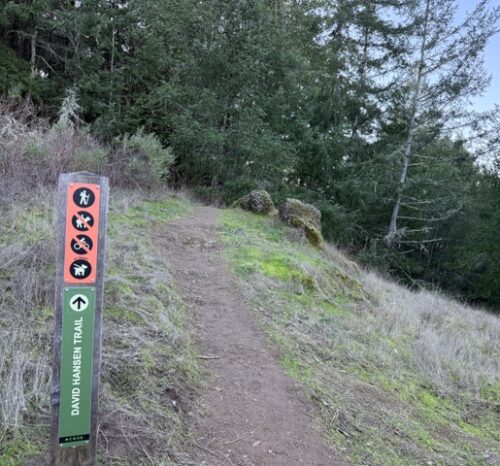 The Roy Redwoods! It’s a nice little trail. I was instrumental in the 70s in acquiring a lot of property, but Roy Redwoods, particularly, was a personal project of mine. It’s 300 acres or so. When I retired in 2008 from the Marin County Open Space District, the board of supervisors named the trail after me, which I was very flattered about, of course. I don’t hike it enough, but I do like taking friends down. It’s a beautiful property. (Read Tracy Salcedo’s reflection on the David Hansen Trail here.)
The Roy Redwoods! It’s a nice little trail. I was instrumental in the 70s in acquiring a lot of property, but Roy Redwoods, particularly, was a personal project of mine. It’s 300 acres or so. When I retired in 2008 from the Marin County Open Space District, the board of supervisors named the trail after me, which I was very flattered about, of course. I don’t hike it enough, but I do like taking friends down. It’s a beautiful property. (Read Tracy Salcedo’s reflection on the David Hansen Trail here.)
What were some of the bigger challenges for SMP and Sonoma Mountain in the old days, and how did you work through it?
Well, the biggest challenge was Lafferty. It is owned by the city, but had poor access back then, no access at all, because of the landowners on Sonoma Mountain.
Peter Pfendler was a retired attorney who made his living off selling surplus airplanes from the Vietnam War. He actually was an environmentalist in his own way. He contributed a lot to saving the California condor. He spent a lot of money on that, but he was very anti-public access. He just didn’t want “the great unwashed” coming up near his property. He worked with a number of his neighbors who owned property around that area, to have them put covenants on their deeds to restrict public access if and when it ever came to working with public agencies. Many put covenants on their deeds, making it very difficult to acquire property without going to court.
Pfendler is no longer with us, and I think the land is currently undergoing a change. But I worked a little bit with Pfendler when the city manager was trying to get me to put some money into Lafferty. I had refused because Lafferty was already owned by the city; the issue was access to it and the access was over adjacent property. I was gone by the time they finally got access.
McRae also created a huge stir. He originally offered a trail easement and actually worked on building a trail on his land with LandPaths, and then he backed away. We had to go to court with the county for the open space district to get those rights back. LandPaths was a big part in working to get access at Lafferty. The open space district could only deal with willing sellers. We had to work with owners that were willing.
I also worked with LandPaths after I retired and was on the board for about 15 years.
Is there anything that you think is a pressing issue on Sonoma Mountain right now?
Miranda, my daughter, witnessed the fire in the lithium battery plant down near Santa Cruz. She was coming back from Monterey and the fire had just started. She’s worried about the Moss Landing’s Elkhorn Slough that comes out near that area. I paddle in that slough. It’s incredible, one of the biggest sanctuaries for otters and bird life. This lithium battery thing is a concern, especially with the fire risk. Now that they want to build a lithium storage facility in Petaluma at the foot of Sonoma Mountain, well, I hope they really consider the impacts it could have on the land and the local residents.
Internally, I think SMP needs to get people from the district back on the board, the state parks, and the land trusts. That’s the sort of group Pat and Mickey originally put together. When Kim Batchelder recently left (from Sonoma County AG and Open Space), it left a little bit of a hole. So, I advocate for more public agency membership for the board.
What do you hope to see in SMP’s future?
I am hoping to see more focus on the watersheds of Sonoma Mountain and making those connections with groups. Interest in protecting the watershed is a big part of Friends of Petaluma River. I’d like to see that connection to Sonoma Mountain Preservation. I know some talking has been happening, but not sure how much yet.
I’d be great to get SMP more involved in educational groups. Friends of the Petaluma River has a great connection with teachers and others through their school programs, and I think it would be wonderful to get more school kids up on the mountain to really understand the watershed and how much that whole west side of the mountain plays a major part in the watershed. Also, there’s the United Anglers of Casa Grande high school. They did an amazing restoration of Adobe Creek, which has its headwaters at Lafferty Ranch. I would like there to be classes and work on the trail up there at Lafferty, with the kids. I know there was a pilot program SMP did a couple of years ago with school kids, Write Over the Mountain. That was a start, but we need to keep doing it.
I also think the Ridge Trail is important. The district is working on some properties along the ridge to the south. The challenge is to really determine where the trail will go—over the mountain or around the mountain? I think people want it to go over the mountain, but it’s gonna be difficult. The district is really the key to getting the rights. With Jack London State Park, you’ve got pretty good access and a connection with the North Slope Trail. They both tie together beautifully, and then it could go all the way to Freiburg, which goes down the upper ridgeline towards the south.
Do you have any stories or anecdotes about Sonoma Mountain?
When I came to Sonoma County, one of the people that really pushed me to be the general manager of the district was Bill Kortum. I would see him at events, and he always had this vision that he would tell me about Sonoma Mountain. When you come from the Marin County border on Highway 101, you come up over the hill from the creek where the county line is, and you look out. The first thing that you see is this huge, beautiful mountain laid out right in front of you; where the world begins. You can see it from beginning to end, and that’s a vision that Bill Kortum wanted to see preserved, in as much of a natural state as possible. That has always influenced me in the sense of what should happen on the mountain, because one of the mandates for open space acquisition is visual impact and lessening development in areas that have visual impact. Even though we concentrated on what we called community separators—the empty lands between the towns—being the number one priority, the upland slopes were the second priority. Certainly Sonoma Mountain, Taylor Mountain, Fitch Mountain, all of these mountains in the county needed to be protected and preserved as much as possible. That was Bill Kotum’s vision and it became my vision.
That’s one story. The other was my confrontations with Mr. Pfendler and his group, and the controversy that tangled me in the middle of that which I didn’t want to be involved in.
They were a bit like Nature Conservancy. Nature Conservancy was formed to protect particular habitats for species, and that’s their main focus. However, they have a lot of money and they bring in very wealthy people. Pfendler was a very wealthy person who felt that he could be an environmentalist, but he just didn’t want what I call “the great unwashed” anywhere near these properties. That’s a little bit of a problem I have with Nature Conservancy. They attract people like that. They might create beautiful open spaces, but they just don’t want the people involved or be enjoying the land, even though they are.
What advice would you offer to the next generation of conservationists dedicated to preserving areas like Sonoma Mountain?
Keep the faith. In today’s particular political climate, I think we have to be strong about all of the efforts to eliminate environmental preservation and protection, for the sake of our planet. I like to think that my life has been focused on preserving native and natural lands. And I think people can get discouraged when they see the political winds blowing the other way, and so I think for young people they have to be strong about it.
I worry about my grandsons, who are 8 and 12, because they’ll be around at the end of the century, hopefully. What is gonna happen by the end of the century? I constantly give them books about nature and about preserving the land and keeping our natural areas healthy. I don’t know whether my grandsons will really pick it up, but I’m hoping they do. I come from a family of rangers and park people. My wife worked at Marin Parks. One of her nephews is the chief of fish and wildlife up in Alaska, and the other works for San Anselmo Parks. My son is a big natural habitat person, but he’s a DJ. He takes the boys out a lot into nature, and we want to get them to join the camp at Friends of the Petaluma River. They have some nice kid camps.
I’m concerned that the only way to improve confidence is to make sure that young people are well educated in terms of what’s happening with the environment. They don’t have to be land preservationists like me. It’s very hard to get into jobs in land preservation, but there are many ways preservation can be supported.
I’d like to think that I’ve influenced my daughter. She moved down here from Portland and decided on her own to join the SMP board, and there was an opportunity. She’s got years of experience with environmental nonprofits and she’s got a unique perspective looking at it from a health lens, through her master’s degree in Ecopsychology. I think you’ll be interviewing her next.
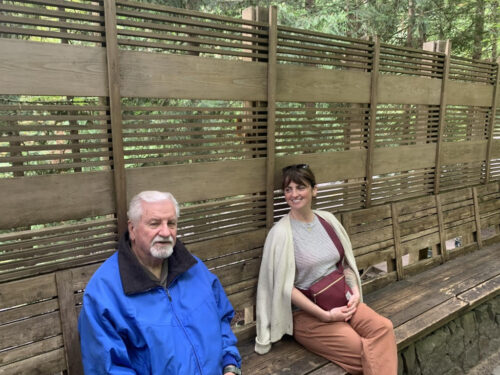
David and Miranda Hansen.
Connect with SMP
Sonoma Mountain – The Book!
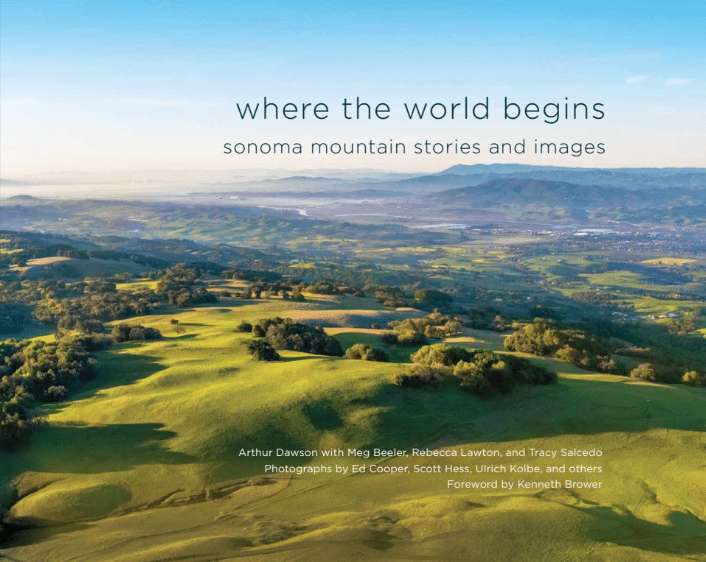
Where the World Begins: Sonoma Mountain Stories and Images draws you into our inspiring natural treasure at the heart of southern Sonoma County. Local Bestseller, IPPY Award 2020. Two purchasing choices below:
